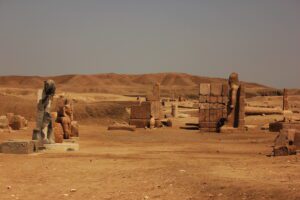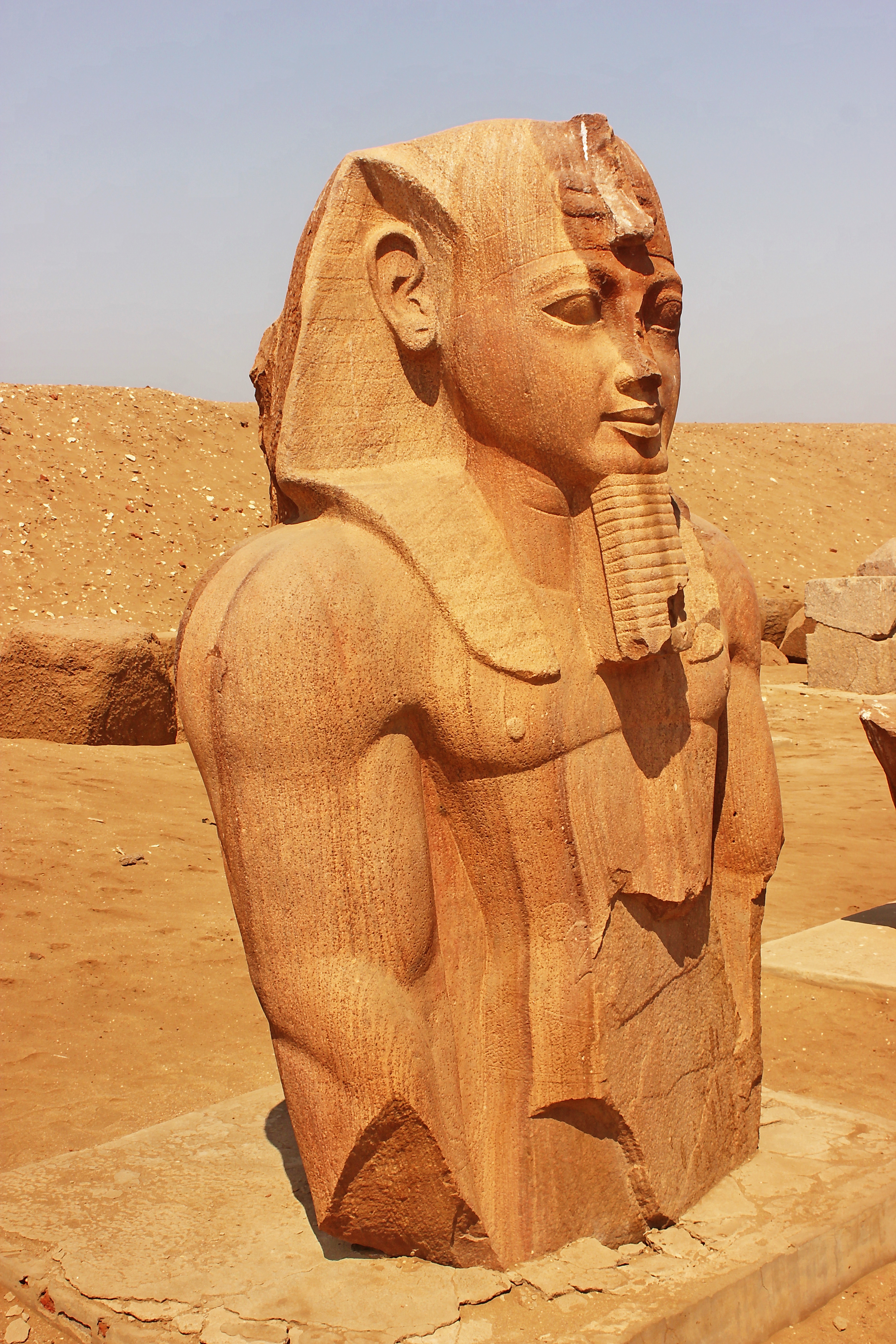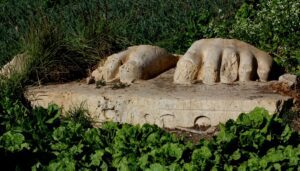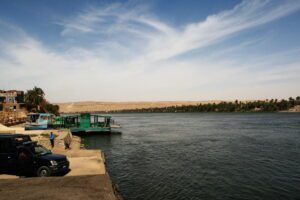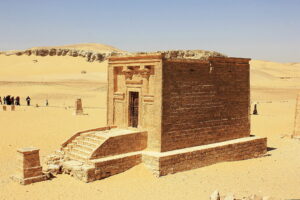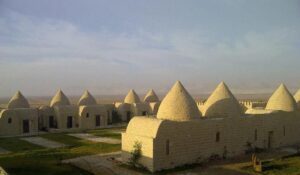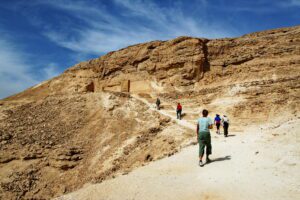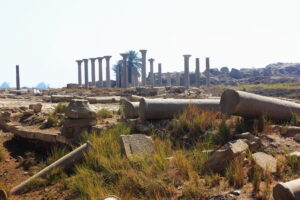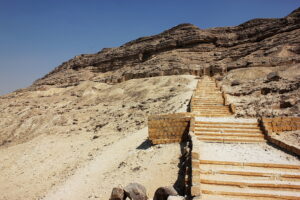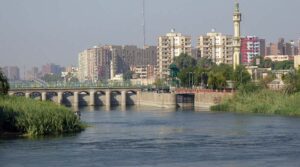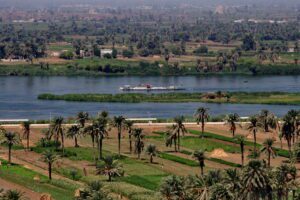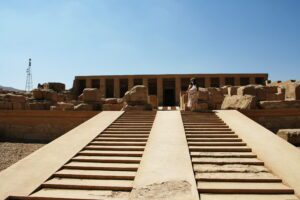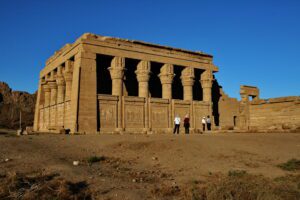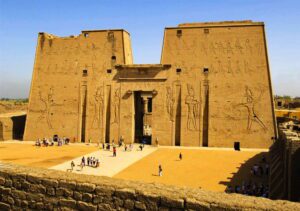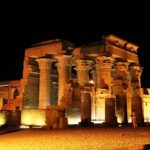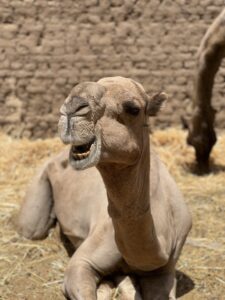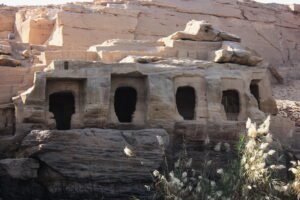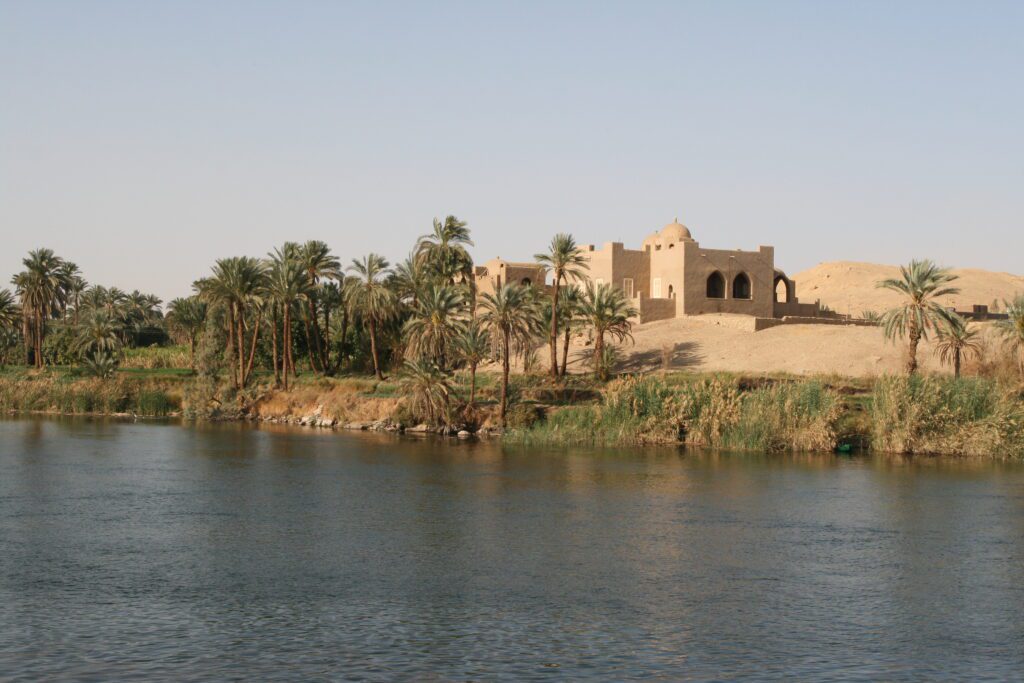
Nile Valley and Delta
Nile Valley – North of Egypt all the way down to Aswan anywhere the Nile flows through, off the beaten tourist track but sights can be added to the main tours.The Delta, a lush green triangle set in a desert landscape, Delta fans out between the two main branches of The Nile. Ramses II ruled from here three thousand years ago. Now The Delta region produces the bulk of the country’s crops, helping to feed the huge population. Egypt has been called the gift of The Nile, for without the river it could not exist as a narrow and verdant strip of cultivated lands cuts through the arid country. The whole of the Delta is farmland, irrigated by a web of tributaries and canals, and is said to be one of the most fertile agricultural regions in the world.In ancient times a great civilization flourished along the river’s banks and the incredible wealth of temples and tombs left behind, make the Nile Delta and valley the greatest open-air museum in the world. Middle Egypt is chiefly known for its temples at Abydos and Dendara, tourists also like to visit the Tombs of Beni Hassan and the ruins of Akhenaten’s capital at Tell el-Amarna.Almost every Nile town is built upon layers of previous settlements, Pharaonic, Ptolemaic, Roman, and Coptic.
Nile Valley & Delta
- TELL-BASTATell-Basta is the modern name for the site of Per-Bastet, or the ‘Domain of Bastet’, the home of the cult of the cat goddess. Strategically, Per-Bastet had been an important place from early times but reached its peak during the Third Intermediate Period and the late period (1081-332 BC). The Greeks gave it the name ‘Bubastis’. After Herodotus visited it in the 5th Century BC, he described the town as having a beautiful temple to the cat-goddess Bastet in the centre of the city. He also gave a vivid account of the annual festival held here, when around 700,000 Egyptian pilgrims would visit the site. The building of the temple began in the 4th Dynasty (2609-2551 BC), by Khufu and Khafre, the builders of the Great Pyramid, and following Pharaohs made their additions to it over the next seventeen centuries. Although this architectural gem once rose above the city, today the temple is just a pile of rubble, destroyed as an archaeological site with modern housing now covering about two-thirds of the area. However, it is possible that there may be more monuments of this period still to be uncovered. A collection of gold and silver vessels and jewellery was discovered by local workmen near the temple site in 1906, and is now in Cairo Museum.

- TANISTanis lies in the Eastern Delta, and today, it is known by the name San el-Hagar. It was the capital of the Late Period (724-332 BC), and is better known by its Greek name Tanis, though it is thought to be called Zoan in the Bible. Tanis is similar to the southern capital, Thebes, but on a smaller scale. Today, the city covers around 180 hectares, and though it appears to be a mound of rubble, Tanis has unveiled a wealth of very important monuments, possibly making it the most impressive site known in the Delta. Some kings of the 11th and 12th Dynasties were buried underground in stone chambers in Tanis. The kings liked to reuse sarcophagi from the New and Middle Kingdom periods, and their tombs were furnished with a considerable amount of burial equipment and jewellery which perhaps could be said to demonstrate their attachment to the burial traditions of the past. The treasures of the Tanis necropolis are considered the most important source of our knowledge of the Third Intermediate Period royal funerary systems and the breathtaking treasures can be seen at the Egyptian Museum. The technical capabilities of the craftsmen and metalworkers who crafted these tombs probably equalled that seen in Tutankhamun’s tomb. The city of Tanis contained enormous temple structures like the temple of the Sun-god Amon-Re; built largely from re-used material from Per-Rameses (which itself had re-used many older monuments), and other Delta sites. Attached to the rear of the temple are 10 palm columns dating back to the Old Kingdom and two obelisks. In total 23 obelisks have been found at Tanis, forming a sort of open-air museum. The site is wrongly identified as the Biblical city of Per Ramses. Recently a new discovery proved that Per Ramses has been relocated from another site close by when it was submerged by the Nile flood. The original location of the city lies in Qantir.

- QANTIRQuantir is the site of the great Delta capital of the Ramesside kings (1304-1081 BC), known in ancient times as Piramesse or Per-Rameses. Qantir city was believed by many to be the city from where Moses led the Exodus – the biblical Pithom. Today the site is buried under agricultural lands. The area is covered with sandy mounds which archaeologists now believe hide a number of important monuments dating from the Middle Kingdom through to the Late Period (2061-332 BC). It would be virtually impossible to excavate the whole area of Qantir due to the modern settlements which have encroached upon the site, but with the aid of magnetic sensors and measuring equipment and data transmitted to computers, the plan of Rameses’ vast city is now being slowly revealed. This has become one of the most exciting discoveries of the 20th century with settlement areas, places of worship and the necropolis now being carefully mapped out.

- MinyaThis area sits between Upper and Lower Egypt and is home to important historical sites, including Tell el Amarna, known as the City of Akhnaton (Akhenaten), and the necropolises of Tuna el Gebel and Beni Hassan.

- Tuna El Gebelis the largest Graeco-Roman necropolis in Egypt. It is the necropolis of the ancient city of Hermopolis, which was a city of creativity, philosophy, and enlightenment, where the philosophical Hermetica was written. The area includes homes, temples, and tombs. Most structures are dated from 300 BC to 300 AD. The earliest tombs were constructed of local shell-limestone and resembled small temples. From the early Roman period, mud-brick tombs were built and the necropolis expanded substantially. One of the best-known tombs is that of Petosiris, a priest of the god Thoth. The vivid tomb scenes include images of agriculture and the care of animals and birds. In the catacombs of the necropolis were found tens of thousands of mummified ibis birds and also baboons, both sacred to Thoth. Most are from the 4th century BC and include mummies in sarcophagi and jars. Other highlights include the Tomb of Isadora, and a water wheel and aqueduct. Much of the area is still to be excavated, and it will continue to show us how the Greeks and Romans lived and teach us about how they became Egyptanized through interaction with the local people. More information about ongoing excavation research can be found at https://www.tuna-el-gebel.com/en More about the mummified ibis: https://www.jstor.org/stable/23788261 We highly recommend the book “Divine Creatures-Animal Mummies in Ancient Egypt” by Salima Ikram

- New HermopolisThis ecological complex offers accommodation (a retreat), including a library, and a restaurant, but it is unique in Egypt because it offers engagement with philosophy, connects the past of the area to the present, and involves and supports the local community. New Hermopolis was founded by Dr. Mervat Abdel-Nasser with the mission of capitalising on Middle Egypt’s heritage for the cultural and economic development of this region. Its founding is connected to the thought and philosophy of Ancient Hermopolis, with its belief in the possibility of harmonious living and the power of art to transform society. It was built in a unique architectural style in Tuna El Gebel village, Minya. Set amid landscaped gardens and against a backdrop of breathtaking mountain scenery, the architecture is in harmony with the outside desert landscape and was influenced by nearby Beni Hassan and the work of architect Hassan Fathy. New Hermopolis also serves as a cultural space, holding events from workshops to performances for the benefit of the local community and international visitors. It also has an organic farm, and produces extra-virgin olive oil. The famous Egyptian blue lotus/water lily shown in many ancient Egyptian artworks is grown here, and limited quantities of perfume oil and tea are produced from its flowers. More about the connection of philosophy between New Hermopolis and the original city: https://www.newhermopolis.org/philosophy.php We recommend the book “The Path to the New Hermopolis: The History, Philosophy, and Future of the City of Hermes” by Mervat Nasser.

- The Boundary Stelae Of AkhenatenThese rock inscriptions in the cliffs around Akhetaten, the city founded by Akhenaten, are among the oldest recorded statements of the foundation of a city. They present the city as being made for the god Aten, the visible form of the sun god Ra. After the death of Akhenaten, the city lost its position as the royal power base, and its monuments were dismantled under subsequent rulers. By the reign of Ramesses II, the name and image of Akhenaten were purposefully destroyed because of his prioritizing the Aten over other gods. Images above the inscriptions on the boundary stelae were erased, as were references to the king in the inscriptions. There are two groups of stelae. Three are on the northern and southern ends of the cliffs east of the city, on the east bank of the river; although damaged, they have the same inscription of dedication as the city to the Aten. The other 11 stelae have similar inscriptions and give a clearer indication of the extent of the city. The boundary stela we will see shows Akhenaten with his wife Nefertari and their daughters presenting offerings to Aten. More about the Boundary Stelae https://oi.uchicago.edu/sites/oi.uchicago.edu/files/uploads/shared/docs/ar/81-90/83-84/83-84_Amarna.pdf We recommend the book “The Boundary Stelae of Akhenaten (Studies in Egyptology)” by Professor William J. Murnane and Professor Charles C. Van Siclen III.

- El AshmuneinNear this village was the city of Khemenu (Ḫmnw) which means “town of eight”. According to a creation myth, there were eight primeval deities, four frog gods and four snake goddesses, who created the cosmos here. It was known as Shmun in Coptic, and its modern Arabic name is derived from this. This was a center of worship for the god Thoth, the god of wisdom, writing, and healing, who was often depicted in the form of a baboon or as a man with the head of an ibis. It was known during Greco-Roman times as Hermopolis, or the City of Hermes, as the Greek god Hermes was associated with Thoth. Monuments include a ruined agora and an early Christian basilica which was built on the site of a Ptolemaic temple. Among the remains of a temple built by Rameses II, excavators in the 1930s found more than one thousand re-used talatat (small blocks of limestone that made construction easier because of their relative light weight) brought from the dismantled Aten temples at Amarna. Two large baboon statues over 4.5 meters high remain, probably from the entrance to the Temple of Thoth, built by Amenhotep III. There is also a small museum. The city was planned and included the Great Temple of the Aten, the Small Aten Temple, royal residences, and government buildings. We explore the ancient city and necropolis remains, including the palace where Akhnaton, his wife Nefertiti, and his son Tutankhamun lived; temples; the royal tomb; and the tombs of the nobles.

- Beni Hassanis a unique site because in the upper cemetery, the images and inscriptions on the walls of some of the tombs still have their original colours and details, showing traditional scenes of daily life. Dating from the 6th to 12th Dynasties (the late Old Kingdom, First Intermediate Period and into the Middle Kingdom), the tombs are cut into two ridges half-way up the mountain. They have an impressive view across the escarpment and the Nile. In the upper cemetery are rock-cut tombs of the administrators of the region. The lower cemetery has a series of shaft and pit tombs at the base of the cliffs; it includes tombs of officials who were connected to those buried in the upper cemetery. Among the best known tombs are those of Khety, Baqet I and Baqet III from the 11th Dynasty, and Khnumhotep I, Khnumhotep II and Amenemhat from the early-mid 12th Dynasty of the Middle Kingdom. The number of tombs accessible to the public varies, usually there are four. Among the famous scenes depicted here are wrestling and possibly a documentation of the visit to Egypt of Biblical Abraham (or Ibrahim). The view of the area is excellent. Also a highlight is the current cemetery, which we will see on the way. It features a specific dome architecture, which was a source of inspiration for the architecture at New Hermopolis.For more information, visit https://benihassan.comA virtual tour of the tomb of Kheti in Beni Hasan, but being there yourself will be more exciting https://my.matterport.com/show/?m=QaGBAsT6yg4&mls=1

- AssuitThe Dayr Al-Muharraq Monastery, The Monastery Of The Holy Virgin Of Al–Muharraq, is surrounded by a wall modelled after the wall of Jerusalem. For Egypt’s Coptic Christians, a pilgrimage to this monastery is equal to a pilgrimage to Jerusalem. Tradition relates that the Holy Family stayed here for six months and five days, and that this is where Jesus returned after his resurrection and consecrated an altar in order to fulfil the prophecy in Isaiah 19:19 “in that day there will be an altar to the Lord in the midst of the land of Egypt”. This was the point furthest south in their journey and their longest stay in one place in Egypt. The holiest place in the monastery is the Church of the Holy Virgin. It is said that the altar was consecrated in the first century AD, which would make it the first church in the world. It has a collection of icons from the 18th and 19th centuries. In 1880 and 1964, the monastery constructed two more churches and dedicated them to the Holy Virgin. Dayr al-Muharraq also has a century-old episcopal palace and a keep dating from the 6th century.

- SohagThe city of Sohag gives us access to two monasteries: White Monastery Of Saint Shenouta The Archimandrite The name of this Coptic Orthodox monastery refers to the white limestone of its outside walls. Shenouta of Atripe, also known as Sheoute the Great of Saint Shenoute the Archimandrite, lived in the 5th century AD and was the abbot of the monastery. He is considered a saint by the Coptic church. He became head of a monastic federation comprising several monasteries for men and women, where the Pachomian Rule of shared work and prayer was strictly interpreted. He was the first prolific writer in Coptic, the language of the common people. Much of his work survives and is an excellent source of information on aspects of 5th and 6th century monastic life in the region. The monastery was still functioning in the 12th century, but was reported as being in ruins. The church, which was built in the middle of the 5th century, survives. In the 7th century, fire heavily damaged the church. It was renovated to the old plan, and columns and capitals were reused. A khurus was inserted in front of the sanctuary, although the existing khurus was most likely built in the eleventh or twelfth century. Paintings survive in the central and southern semi-domes and on the ground floor. Inscriptions in Coptic and Armenian date some of the paintings to the 12th century and document the presence of Armenians in the monastery at that time. Excavations of the monastic settlement surrounding the church are in progress, and a study of the literary corpus of Saint Shenouta is being undertaken by an international group of scholars. The Red Monastery A Coptic monastery that dates to the 5th century AD and still functions as a church, the Red Monastery is considered to be one of the most important monasteries established during the early history of Christianity. It is known as the “Red Monastery” because of the red bricks that make up most of its masonry. White limestone was also used in the construction, as well as pink and black granite columns. The monastery was founded by Saint Bishoy at the beginning of the 4th century AD. It suffered two fires, the first during the Roman Period and the second as a result of Berber attacks. All that remains is the church and the surrounding fortification walls to the south. Remains of a structure north of the church also survived and are thought to belong to an industrial area. For decades, visitors to the church saw only darkened suggestions of what once was among Byzantine Egypt’s most beautiful painted sanctuaries. Many of the paintings date back between the 6th and 8th centuries. The central basilica had been in ruins for periods of its 1,400-year history, and conservation was challenging. There were problems with the previous, faulty restoration. A major conservation project was carried out between 2004 and 2014 by the American Research Center in Egypt with funds from the USAID (U.S. Agency for International Development). From lighting to stonework, a new altar to re-used columns, a multinational preservation team dealt with everything from termite and bird damage to leaky roofs and replacement doors. The team consolidated, cleaned, and conserved the paintings, which revealed their original beauty. Now we visit the church in its full splendor. A virtual tour of the Red Monastery gives just a hint of what you will see. https://my.matterport.com/show/?m=Yyw1F5eGxxZ&mls=1 Read about the architectural conservation project here: https://www.arce.org/project/red-monastery-architectural-conservation

- Abydos TempleAbydos is about 10km (6 miles) from the Nile. It is one of the most important archaeological sites of ancient Egypt. Abydos was seen as the gateway to the afterlife for ancient Egyptians. From prehistory graves were situated here, and tombs of the early dynasties were built here even though Abydos was not the seat of power, as it became a pilgrimage center for worship of the god Osiris. The tradition of tombs being built here continued throughout ancient Egyptian history. The earliest occupants of the area were the people of el-Amra, then of Nagada who built a prehistoric and protodynastic village which later became the city of Abdjou (Abydos is the transcription of the Egyptian name) with protodynastic kings whose capital (This) was slightly further north and whose main necropolis was in the area of Um el-Qaab. Numerous temples, often dedicated to the local divinity, also go back to the Thinites period, as well as two fortresses in Shünet el-Zebib. The importance of Abydos rose with the establishment in the 5th dynasty of the cult of Osiris, who was believed to be god and ruler of the earth. It was believed the city held his main tomb. Antef II (11th dynasty) made Abydos the city of Osiris and main center of the Osiris cult. Ancient Egyptians believed that being close to the god of the dead increased their chances of resurrection and eternal life. Wishing to be buried or symbolically buried there, some pharaohs from the 2nd dynasty onwards and followers of Osiris constructed small brick cenotaphs or stelae near the tomb of Osiris. The Book of the Dead calls Abydos “the island of the Just” and contains a specific formula “to enter Abydos and become part of the retinue of Osiris”. Most of the monuments of Abydos are based on this belief. They include large necropolises from various periods located between the city area and the temples which today are most significant, those of Seti I and his son Ramses II. Abydos reached the height of its glory under these two kings. The temple of Seti is an exceptional example of architecture and art. The temple was built mostly of limestone, with the occasional use of sandstone in different areas throughout, and has an unusual L-shaped ground plan. The temple was completed after Seti I’s death by his son, Ramesses II. The courtyards were decorated by Ramesses II with scenes from the battle of Qadesh and of the king offering to the gods. The second hypostyle hall has thirty-six columns similar to the ones in the first hypostyle hall, decorated with scenes of Seti I kneeling before the gods. There are seven chapels dedicated to seven gods: the deified form of Seti I, Ptah, Re-Horakhty, Amun-Re, Osiris, Isis, and Horus. The chapels are decorated with scenes of the king offering to the gods and of him receiving in return the symbols of life and dominion, as well as royal insignia. The temple’s southern extension contains more chapels including one where the barques used to carry the statues of the gods during ceremonies were kept. We also see the famous Abydos King List, the list of kings who governed Egypt from the first Thinite Kings up to Sethi I himself, with the exception of three kings (1359-1342) omitted on purpose including Akhenaton who was considered to be a heretic. Other highlights of Abydos include the Osirion, Ramses II temple, the tombs of the early dynastic kings, and the tomb of Umm Seti (Dorothy Louise Eady (1904 -1981) an English woman who lived for 25 years in Abydos and was renowned for her interest in recording the traditional and popular customs of the people and linking them to ancient Egyptian history, and who also believed known that in a previous life she had been a priestess in ancient Egypt, Abydos continues to be a cult centre and pilgrimage destination for many visitors from around the world. Recommended books: The Monuments of Seti I: Epigraphic, Historical, and Art Historical Analysis by Peter J. Brand

- Dendera TempleDendera is approximately 80.5 km (50 miles) north of Luxor, on the Nile West bank. The Temple of Hathor has recently undergone restoration to reveal clearly the beauty and colour of the art. Nine stone terraces were built to the left of the entrance gate to display statues and artifacts. The site covers approximately 40,000 square meters (430,556 square feet). The ceiling decoration is one of the best preserved of the surviving ancient Egyptian monuments, showing how vibrant colors were used. There is evidence that the Old Kingdom pharaoh Pepi I built religious structures here. There are remnants of a temple constructed during the eighteenth dynasty (New Kingdom). The later additions to the site date to the Late Period. The Temple of Hathor dates to the first century BC and was continually developed through the Ptolemaic and Roman eras. It refers to both Egyptian rulers and Roman emperors. The site also includes birth houses, a chapel dedicated to Isis, the gateways of Domitian and Trajan, and a Coptic Christian basilica, circa 5th century AD. The famous Dendera zodiac bas-relief was removed from the temple in 1820 by the French and replaced with a reproduction. The original is now in the Louvre Museum in Paris. On the temple exterior is a carving of Cleopatra VII Philopator (the most widely known of the rulers called Cleopatra) and her son, Ptolemy XV Philopator Philometor Caesar (known as Caesarion), whose father was Julius Caesar. Esna not included on the old website, but should be? What about Bisaw and other stops on DNS, they should be included because we include DNS tours also on this website? Esna is part of the Luxor governorate. Esna is about an hour drive (60 km / 37 miles) from Luxor. It is an unassuming town with surprises, as its rich history across the centuries is increasingly being recognized with restoration and development. The Greco-Roman Temple and a previous temple built here by Tuthmosis III were dedicated to the ram headed god Khnum. The Temple of Khnum owes its unique situation to Nile floods which buried it; modern Esna was built over it. Excavation from the 1860s revealed the hall, built during the reign of the Roman emperor Claudius (AD 41-54). The temple sitting 10 meters (33 feet) below street level gives you a feeling of what it must have been like for those who excavated other semi-buried monuments elsewhere in Egypt. Esna was known by the ancient Greeks as Latopolis because the Nile perch (lates in Greek) was worshiped here; in 1902, thousands of mummified Nile perch from the Greco-Roman period were discovered. Previously most visitors came to Esna specifically to see the temple. Esna has become increasingly worthwhile to visit with the restoration and reopening in 2021 of the Wekalet Al-Geddawi, a caravanserai built in 1792 to store goods and as lodging for traveling merchants. You will also see 19th Century homes and the redeveloped old Ottoman market of Al-Qissariya adjacent to the temple, and some of Esna’s heritage of craft traditions. There are two dams, one from the colonial period and a new dam that has two locks. This is why on Dahabiya Nile Sailing tours we prefer starting dahabiya tours from Esna – we can avoid going through the locks. Exceptions are dahabiya tours that run in the other direction, from Aswan. There are also some dahabiya tours that start in Luxor and cross the lock, however these take six or seven nights. For more insights to Esna https://www.instagram.com/discoveresna

- EdfuEdfu is a substantial market town and traveling by horse drawn carriages is the most convenient way to visit the temple from where our dahabiya docks. We use the carriages as there has been improvement in treatment of the horses and using the carriages supports the local economy, and also ensures these horses will be better fed and looked after. Guests should keep in mind that Arabian horses are different in build to European horses, they may seem thinner but this is not necessarily due to lack of food or care. We try to ensure the drivers treat the horses well, but if you have any concerns about this please mention it to your guide. The Temple of Horus is a highlight for many people on their visit to Egypt. It is in excellent condition, partially because its construction began in the 2nd Century BC under Ptolemaic rule. It was built on the site of a smaller New Kingdom temple. It was dedicated to Horus and to Hathor of Dend era. From the grand entrance and through the courtyard you are awed by its scale, but the massive walls and an abundance of hieroglyphs are only part of this temple’s attraction. In the inner temple, the hypostyle hall and in the sanctuary you will feel the many different moods of this constructed space. Seeing the temple now, it is interesting to realize that it was buried until a few hundred years ago, with excavation started in the mid 19th Century. This helped to protect the temple so we are fortunate to see it in such excellent preservation. View Tell Edfu to the West of the temple, which includes houses dating from the Old to New Kingdom. If time allows we also stroll through the local market. If time allows, we will also walk through the local market.

- Kom OmboThe approach to this site from where the boats dock makes it clear why the crocodile-featured Sobek was one of the gods it is dedicated to (along with Horus). The connection to the power of the Nile is unmistakable as you look towards the temple. The importance of the town in the past was due to trade from further north in the Nile Valley passing through here to Nubia. The remains of the ancient town are buried, but the temple complex was excavated and restored in the late 1800s and has many fascinating features among the reliefs. The symmetry of this site is something visitors interested in architectural planning will especially appreciate. You can also visit the Crocodile Museum which includes some impressive mummified crocodiles. If you are specifically interested in crocodiles in Egypt, I suggest reading this article by Salima Ikram, Professor of Egyptology at The American University in Cairo: Crocodiles Guardians of the Gateways in Thebes and Beyond


- Daraw Town And Camel Market/BarnExplore a town that will give you a different sense of Egyptian life than what you see in the big cities. We will stop at a cafe to try a local drink such as halfabar. We can plan our dinner for that night and learn how to shop, including a few words of Arabic, then try our new skills in the market while shopping for ingredients for dinner. This is a fun opportunity to interact with the market’s traders. Ask your guide about shopping for other items too, including Arabic words and prices. For example, you could buy a galabeya like you see our crew and villages wear, and then wear it for the final evening party with the crew. One of our guests got a dress (in the style worn by many Egyptian women in their homes, similar in style to the galabiya for men) made for her in half an hour. You will visit a barn for an introduction to camels, giving you some interaction with camels and the opportunity to learn about these fascinating animals and the camel trade. Note: if your tour visits Daraw on Saturday or Sunday, we visit the camel market instead of the camel barn. On Tuesdays we can visit a livestock market.

- Gebel El SelselaThis site between Edfu and Kom Ombo sits where the river bed is narrow and is overlooked by sandstone hills. From the dahabiya, we walk to the shrines and quarry. There are quarries on both sides of the Nile here. We will explore the West side. This is one of the places where views of the Nile are most picturesque. Large amounts of sandstone were quarried here for temple building in Thebes (Luxor) from the Middle Kingdom on, and extensively from the New Kingdom to the Roman period. During the New Kingdom, it was the most extensive quarry in Egypt and gained religious significance as a place where the inundation of the Nile was worshipped. Cut into the rock are the speos (chapel) of Horemheb, with its sanctuary containing seven statues, including Amun and Horemheb; 32 rock shrines, which were owned by private individuals of the 18th Dynasty, and various stelae and inscriptions dating to the New Kingdom. You will be able to see several of the shrines during our walk; some have artwork still clearly visible. You will also visit the huge quarry, which gives some context to how much building material was sourced from this area. There are mason’s marks and graffiti which give a more personal touch to the size of this site. There is also an area of sand where children (and children at heart) can slide and play. Departing on the dahabiya, you get another perspective of the site from the river. Discoveries continue with ongoing excavations in the area. For reading before your tour, you may enjoy the blog of the Gebel el-Silsila Project at http://gebelelsilsilaepigraphicsurveyproject.blogspot.com


